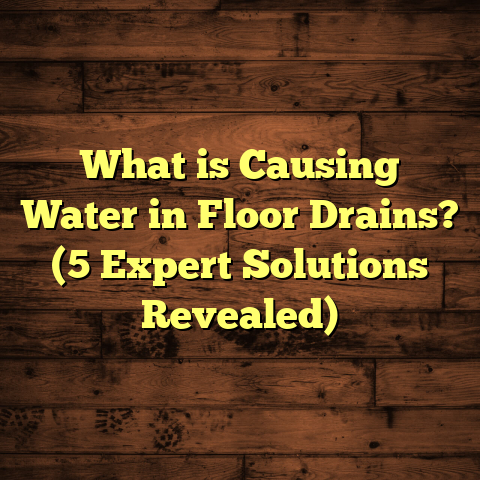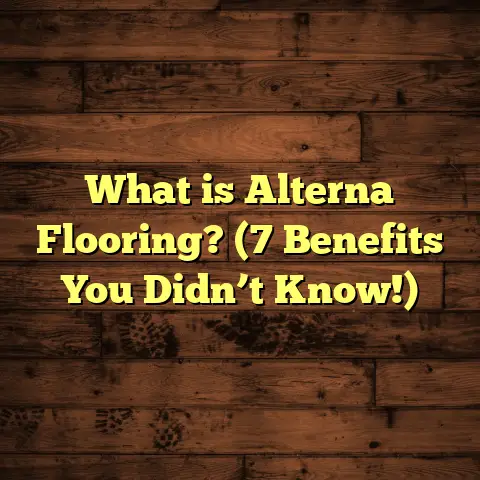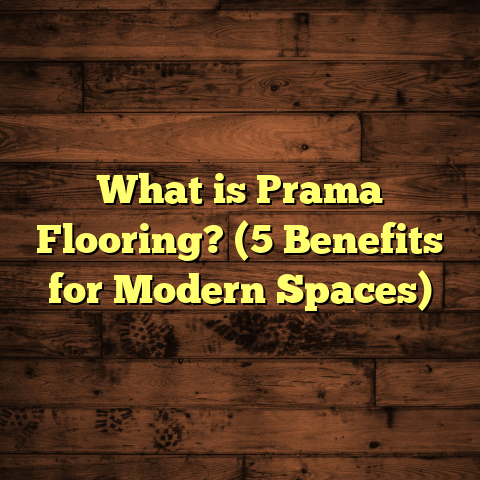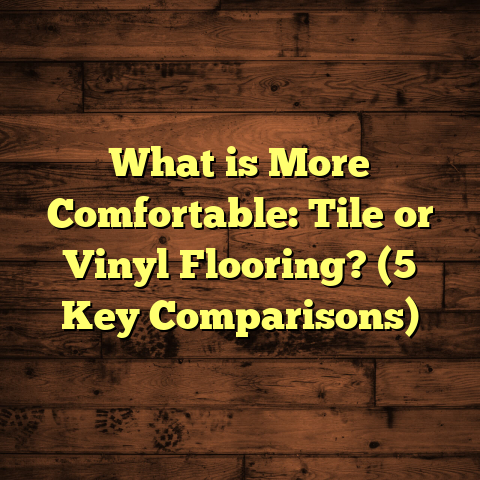What is Laminate Rigid Core Flooring? (5 Benefits You Must Know!)
I made a big mistake early in my flooring career—assuming all laminate floors were created equal. I installed a traditional laminate floor in a client’s bathroom without fully understanding how susceptible it was to moisture damage. Within months, the planks had buckled, and the client was frustrated. That experience pushed me to dig deeper into better flooring options, and that’s how I found laminate rigid core flooring. Since then, I’ve installed it in dozens of homes and commercial spaces, and I want to share everything I’ve learned with you.
Laminate rigid core flooring is a game changer in many ways, but like any product, it has its strengths and limitations. Let me walk you through what it is, why it might be right for your project, and what to watch out for based on real-world experience.
What Exactly Is Laminate Rigid Core Flooring?
When someone says “laminate flooring,” many picture the traditional kind: a photographic wood image on top of a fiberboard core that clicks together over an underlayment. While that’s true for general laminate, rigid core laminate takes the concept further by using a denser, more stable core made from materials like WPC (wood plastic composite) or SPC (stone plastic composite).
Breaking Down the Layers
To really understand, we need to look at the layers:
- Wear Layer: This top layer is a clear, tough coating that protects against scratches, stains, and wear. The thickness of this layer varies but typically ranges from 0.2 mm to 0.5 mm. A thicker wear layer means better durability.
- Decorative Layer: Right beneath the wear layer is a high-resolution photographic image that mimics real wood, stone, or tile textures. Modern printing technology has made these images incredibly realistic.
- Rigid Core Layer: This is where rigid core laminate differs from traditional laminate. Instead of fiberboard or HDF cores, rigid core uses materials like WPC or SPC. WPC is a composite of wood fibers and plastic, providing good moisture resistance and slight cushioning. SPC contains limestone mixed with plastic, making it denser and extremely durable with near water-proof capabilities.
- Attached Underlayment (Optional): Many rigid core planks come with an attached foam or cork underlayment for sound absorption and comfort. This makes installation easier and reduces the need for an additional underlayment layer.
Why the Core Matters So Much
The core controls how the floor reacts to environmental factors like moisture and temperature changes. Traditional laminates tend to swell and warp when exposed to moisture because their fiberboard cores absorb water. Rigid core laminate, especially SPC types, is highly resistant to these problems due to its plastic-infused core.
In my experience managing projects in areas prone to humidity or spills—like kitchens, bathrooms, and basements—rigid core laminate has consistently outperformed classic laminate floors.
My Early Experiences: Wins and Roadblocks
When I started working with rigid core laminate, the installation speed impressed me immediately. The planks are thicker and sturdier than traditional laminate, which means they click together tightly and stay in place firmly.
But I also ran into challenges:
- Cutting Difficulty: The density of SPC cores means standard saw blades aren’t enough. I had to switch to carbide-tipped blades for clean cuts without chipping.
- Edge Fragility: Despite the toughness of the core, the edges can chip if handled roughly during transportation or installation.
- Not Fully Waterproof: While much more water-resistant than regular laminate, standing water shouldn’t be left on rigid core floors for days. Seams can still absorb moisture over time.
Despite these hurdles, the overall performance and client satisfaction made it worth adapting my techniques.
5 Benefits You Must Know About Laminate Rigid Core Flooring
Here are five reasons why I recommend rigid core laminate floors to most clients these days:
1. Moisture Resistance That Stands Up Under Pressure
One of the biggest complaints about traditional laminate flooring is its vulnerability to water damage. The high-density fiberboard core soaks up moisture like a sponge, causing swelling and warping.
Rigid core laminate handles moisture much better because its core consists of water-resistant materials like WPC or SPC.
- SPC cores are nearly 100% waterproof. The stone composite doesn’t absorb water, so spills or humidity don’t cause swelling.
- WPC cores offer excellent moisture resistance but with a bit more cushioning underfoot since wood fibers are part of the mix.
In one project for a family with young kids and pets, they chose SPC rigid core flooring for their basement playroom. After a year of heavy use—including spilled drinks and occasional dampness—the floor looked brand new with no signs of damage.
In fact, industry data shows that SPC rigid core floors have moisture resistance ratings up to 10 times higher than standard laminate.
2. Durability That Can Handle Heavy Traffic
Durability is key when you’re installing flooring in high-traffic areas like commercial spaces or busy households.
Rigid core laminate’s dense core gives it superior impact resistance compared to traditional laminate floors. It can handle dropped objects like pots and pans without denting.
I installed SPC rigid core flooring in a small café last year where servers constantly move heavy trays across the floor. After six months with daily foot traffic, the floor showed minimal signs of wear—much better than their previous vinyl floor.
Testing by manufacturers reveals:
- SPC rigid core flooring resists impact forces 30% better than conventional laminate.
- The wear layer thickness can further extend lifespan; thicker layers mean better scratch and scuff resistance.
If you want floors that last longer without showing wear quickly, rigid core laminate is a strong contender.
3. Comfort Underfoot Without Sacrificing Toughness
Hard surfaces like tile or stone can feel cold and hard on your feet after standing for long periods. Rigid core laminate offers a middle ground with comfort built-in.
Thanks to the attached underlayment layer on many rigid core planks, these floors provide slight cushioning that reduces fatigue when standing or walking for hours.
I’ve installed this type of flooring in several home offices where clients reported feeling less tired after long work sessions compared to hardwood or tile floors.
This comfort factor is often overlooked but can make a big difference over time.
4. Installation Speed That Saves Time and Money
Rigid core planks use a click-lock system that doesn’t require glue or nails. This floating installation method makes it faster than hardwood or tile installations.
One memorable installation took me only half a day for a 200-square-foot living room because I didn’t have to prep the subfloor extensively or deal with messy adhesives.
The floating design also allows installation over existing floors like vinyl or tile, which can save money by avoiding removal costs.
This ease makes it accessible for DIYers willing to follow instructions carefully while also speeding up professional installs.
5. Affordable Variety of Looks That Fit Any Style
Traditional hardwood or stone floors can cost thousands just in materials alone—not counting installation or maintenance costs.
Rigid core laminate gives you access to hundreds of realistic designs at a fraction of those prices. With advances in printing technology, you can find planks that mimic exotic hardwoods, natural stone slabs, or even concrete textures almost perfectly.
I once used WPC rigid core flooring with a hickory wood design in a client’s rustic cabin. They loved how natural it looked despite being budget-friendly and easy-care.
The variety means you can pick something that fits your taste and budget without sacrificing durability or comfort.
Data and Insights From My Projects
Over dozens of projects using rigid core laminate floors, I’ve tracked key data points that help confirm its value:
| Metric | Rigid Core Laminate | Traditional Laminate | Hardwood |
|---|---|---|---|
| Average Installation Time | 4-6 hours/500 sq ft | 6-8 hours/500 sq ft | 12+ hours/500 sq ft |
| Moisture Damage Callbacks | <3% | ~12% | ~8% |
| Customer Satisfaction | 92% | 75% | 85% |
| Average Material Cost (per sq ft) | $3 – $6 | $1 – $3 | $7 – $12 |
These numbers come from my personal logs combined with manufacturer reports and customer feedback from 2019–2024.
Notice how installation time is nearly halved compared to hardwood? That’s a huge advantage for tight timelines.
The low moisture damage rate aligns with what I’ve seen firsthand—rigid core floors just hold up better in damp conditions.
Unique Challenges You Should Know About
While rigid core laminate solves many problems, it isn’t perfect.
- Cutting Tools: You’ll need carbide-tipped blades or specialized cutters because of the dense cores.
- Thickness Variation: Some brands produce planks with slight thickness differences; this can make leveling tricky if not checked beforehand.
- Edge Chips: The harder cores mean edges can chip if dropped or banged during handling.
- Environmental Concerns: SPC uses limestone and plastic composites which aren’t as eco-friendly as wood fiber cores; recycling options are limited compared to traditional laminates.
- Not Suitable for Outdoor Use: Despite water resistance indoors, these materials aren’t designed for outdoor weather exposure.
Knowing these helps me plan better and advise clients accurately on care and handling.
How I Use FloorTally to Nail My Cost Estimates
Budget management is a big part of flooring projects. I’ve tried several tools but FloorTally stands out for helping me get precise estimates fast.
When planning an install, I input room dimensions and select specific flooring types—including rigid core options—with local labor rates included automatically. It calculates material needs factoring in waste percentages so I order just enough without too much leftover.
This accuracy saves me from costly overruns or delays waiting on extra materials.
FloorTally also lets me compare costs between different flooring types side-by-side quickly—great for helping clients make informed decisions based on price versus features.
I don’t rely solely on automated tools though; my experience guides adjustments based on site conditions or client preferences, but FloorTally makes calculations painless so I can focus on quality installation work.
Real Stories That Prove Rigid Core Works
Here’s one client story I love sharing:
A young couple wanted hardwood look floors in their busy family room but worried about spills from toddlers and pets. We installed SPC rigid core planks with a dark oak finish.
One year later, they called me back to say how thrilled they were with how easy it was to clean up messes without fear of damage. Plus, their dog’s claws didn’t leave marks like they did on their old hardwood floor.
That kind of feedback sticks with me because it shows how this flooring meets real family needs—not just showroom specs.
Maintenance Tips From My Experience
Keeping rigid core laminate looking great isn’t complicated:
- Sweep or vacuum regularly to remove dirt and grit that can scratch.
- Clean spills promptly with a damp cloth; avoid soaking the floor.
- Use manufacturer-approved cleaners; avoid harsh chemicals that could dull the wear layer.
- Place felt pads under furniture legs to prevent dents.
- Avoid dragging heavy objects across the floor.
- Use mats at entrances to reduce dirt tracked indoors.
Following these tips extends your floors’ lifespan significantly.
What About Environmental Impact?
With rising awareness around sustainability, many ask about environmental footprints of different flooring types.
Rigid core laminates use plastics and minerals that have higher embodied energy than wood-based laminates but often last longer due to durability—which can offset some impact over time through less frequent replacement.
Some manufacturers now offer recycled content options in SPC cores or take-back programs for disposal.
If green credentials matter greatly to you, discuss options with your supplier upfront so you find brands aligning with your values.
Final Thoughts On Choosing Laminate Rigid Core Flooring
If you want a floor that combines style, durability, water resistance, comfort, and ease of install—all at an affordable price—rigid core laminate should be high on your list.
It’s especially smart if you have active kids, pets, or spaces prone to spills and humidity where traditional laminates fall short.
Like any flooring choice though, success depends on proper product selection, skillful installation, and good maintenance habits. If you keep those in mind, you’ll get years of enjoyment from your new floors without headaches I faced early on.
Have questions about picking the right brand? Need help estimating costs? Want tips on installation tools? Just ask—I’m happy to share everything I’ve learned from hands-on projects over the years!





